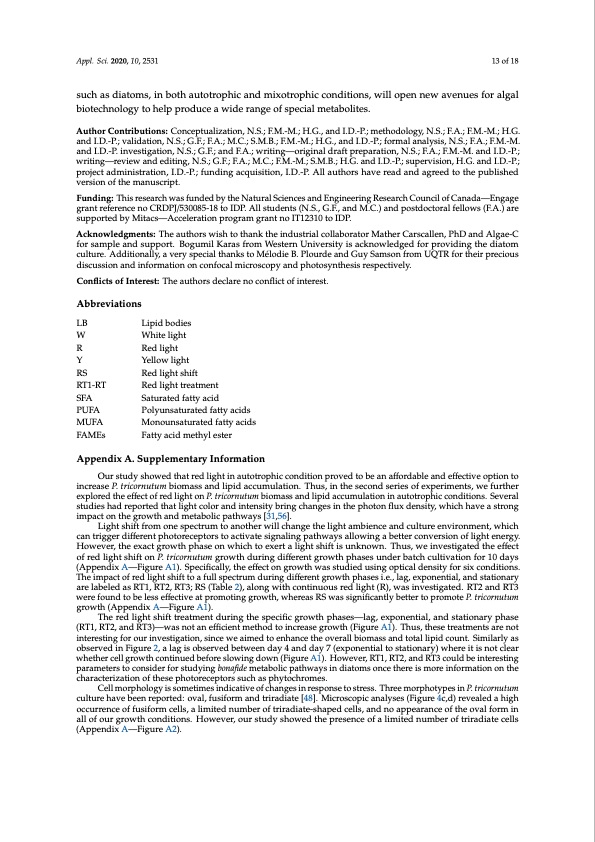
PDF Publication Title:
Text from PDF Page: 013
Appl. Sci. 2020, 10, 2531 13 of 18 such as diatoms, in both autotrophic and mixotrophic conditions, will open new avenues for algal biotechnology to help produce a wide range of special metabolites. Author Contributions: Conceptualization, N.S.; F.M.-M.; H.G., and I.D.-P.; methodology, N.S.; F.A.; F.M.-M.; H.G. and I.D.-P.; validation, N.S.; G.F.; F.A.; M.C.; S.M.B.; F.M.-M.; H.G., and I.D.-P.; formal analysis, N.S.; F.A.; F.M.-M. and I.D.-P. investigation, N.S.; G.F.; and F.A.; writing—original draft preparation, N.S.; F.A.; F.M.-M. and I.D.-P.; writing—review and editing, N.S.; G.F.; F.A.; M.C.; F.M.-M.; S.M.B.; H.G. and I.D.-P.; supervision, H.G. and I.D.-P.; project administration, I.D.-P.; funding acquisition, I.D.-P. All authors have read and agreed to the published version of the manuscript. Funding: This research was funded by the Natural Sciences and Engineering Research Council of Canada—Engage grant reference no CRDPJ/530085-18 to IDP. All students (N.S., G.F., and M.C.) and postdoctoral fellows (F.A.) are supported by Mitacs—Acceleration program grant no IT12310 to IDP. Acknowledgments: The authors wish to thank the industrial collaborator Mather Carscallen, PhD and Algae-C for sample and support. Bogumil Karas from Western University is acknowledged for providing the diatom culture. Additionally, a very special thanks to Mélodie B. Plourde and Guy Samson from UQTR for their precious discussion and information on confocal microscopy and photosynthesis respectively. Conflicts of Interest: The authors declare no conflict of interest. Abbreviations LB Lipid bodies W White light R Red light Y Yellow light RS Red light shift RT1-RT Red light treatment SFA Saturated fatty acid PUFA Polyunsaturated fatty acids MUFA Monounsaturated fatty acids FAMEs Fatty acid methyl ester Appendix A. Supplementary Information Our study showed that red light in autotrophic condition proved to be an affordable and effective option to increase P. tricornutum biomass and lipid accumulation. Thus, in the second series of experiments, we further explored the effect of red light on P. tricornutum biomass and lipid accumulation in autotrophic conditions. Several studies had reported that light color and intensity bring changes in the photon flux density, which have a strong impact on the growth and metabolic pathways [31,56]. Light shift from one spectrum to another will change the light ambience and culture environment, which can trigger different photoreceptors to activate signaling pathways allowing a better conversion of light energy. However, the exact growth phase on which to exert a light shift is unknown. Thus, we investigated the effect of red light shift on P. tricornutum growth during different growth phases under batch cultivation for 10 days (Appendix A—Figure A1). Specifically, the effect on growth was studied using optical density for six conditions. The impact of red light shift to a full spectrum during different growth phases i.e., lag, exponential, and stationary are labeled as RT1, RT2, RT3; RS (Table 2), along with continuous red light (R), was investigated. RT2 and RT3 were found to be less effective at promoting growth, whereas RS was significantly better to promote P. tricornutum growth (Appendix A—Figure A1). The red light shift treatment during the specific growth phases—lag, exponential, and stationary phase (RT1, RT2, and RT3)—was not an efficient method to increase growth (Figure A1). Thus, these treatments are not interesting for our investigation, since we aimed to enhance the overall biomass and total lipid count. Similarly as observed in Figure 2, a lag is observed between day 4 and day 7 (exponential to stationary) where it is not clear whether cell growth continued before slowing down (Figure A1). However, RT1, RT2, and RT3 could be interesting parameters to consider for studying bonafide metabolic pathways in diatoms once there is more information on the characterization of these photoreceptors such as phytochromes. Cell morphology is sometimes indicative of changes in response to stress. Three morphotypes in P. tricornutum culture have been reported: oval, fusiform and triradiate [48]. Microscopic analyses (Figure 4c,d) revealed a high occurrence of fusiform cells, a limited number of triradiate-shaped cells, and no appearance of the oval form in all of our growth conditions. However, our study showed the presence of a limited number of triradiate cells (Appendix A—Figure A2).PDF Image | Red Light Variation Lipid Profiles in Phaeodactylum tricornutum

PDF Search Title:
Red Light Variation Lipid Profiles in Phaeodactylum tricornutumOriginal File Name Searched:
applsci-10-02531.pdfDIY PDF Search: Google It | Yahoo | Bing
Cruise Ship Reviews | Luxury Resort | Jet | Yacht | and Travel Tech More Info
Cruising Review Topics and Articles More Info
Software based on Filemaker for the travel industry More Info
The Burgenstock Resort: Reviews on CruisingReview website... More Info
Resort Reviews: World Class resorts... More Info
The Riffelalp Resort: Reviews on CruisingReview website... More Info
| CONTACT TEL: 608-238-6001 Email: greg@cruisingreview.com | RSS | AMP |